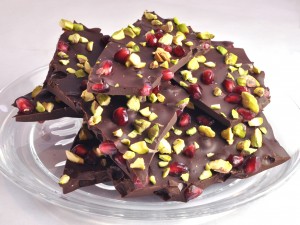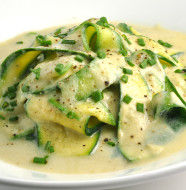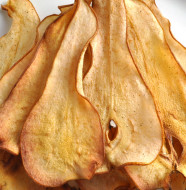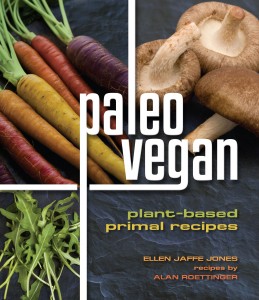I had plans for the family Christmas dinner. It was going to be a fabulous vegan feast, featuring some of the season’s truly remarkable fruits: pomegranates, satsuma tangerines, and fuyu persimmons.Two days before Christmas, just as I was buying the last of the supplies, I began to feel odd. By the time I got home and put everything away, I had a fever of 100.9. I spent the remainder of the week pretty uncomfortably–although I did get out of having to cook or clean a single thing, which was unprecedented, and for a cook, downright miraculous.
I was going to begin with “Pee Wee Potatoes with Olives and Rosemary,” an appetizer I created for my upcoming cookbook, “Paleo Vegan” (actually, this is a book by Ellen Jaffe Jones, who graciously invited me to contribute the recipes). It was going to be just a couple of bites to get people started, and keep them busy while I plated the “Salad of Frisee Lettuce and Fennel with Pomegranate Seeds, Cacao Nibs, and Vanilla Vinaigrette.” And no, I don’t have the recipe for that (yet) because I never made it. Memory is a little foggy on what came (or was meant to come) after that, something with celery root and morels, I think. Then I was going to serve “Polenta with Peppers” (actually, “Peperonata,” from Extraordinary Vegan), and “Sauteed Broccoli-Rabe with Chile and Garlic.” For dessert, I was going to serve “Pears in Pomegranate Juice,” with just the reduced juice as a sauce, a generous quenelle of “Fuyu Persimmon and Satsuma Tangerine Sorbet,” and a broken piece of “Chocolate Bark with Pistachios and Pomegranate Seeds.” I had a nice trockenbeerenauslese in mind to serve with dessert, but I caught the flu one day before I was going to buy it, so that saved a few bucks (quite a few, actually).
I did make the sorbet (it’s in my freezer now, untouched), and couple of days ago, I decided to make the bark, just for the hell of it. I did it the right way, which involves tempering the chocolate, even though it would need to be refrigerated anyway to keep the pomegranate seeds fresh. It’s good to exercise your skills, so you don’t lose them
Tempering chocolate is a process you really don’t need to undertake if your chocolate confection is going to be kept refrigerated, unless you’re keen on having that sharp little snap occur when you break it. For truffles, I prefer a very slight resistance in the shell, an almost ethereal wall encasing the ganache center, a vague demarcation between the creamy interior and the cocoa “dirt” clinging to the exterior, that yields readily to the bite. Bark, on the other hand, seems to me would need to be a more assertive affair–it is wood, after all, so it should crack audibly when broken.
To temper chocolate is to restore it to its original state after melting it. If you don’t do this, the chocolate will not have its lustrous sheen or its firm texture when it cools and hardens. If left unrefrigerated, fat blooming will fairly quickly occur (an unsightly blotching of pale discoloration that, while quite harmless and completely reversible, nonetheless spoils the texture and appearance of the chocolate).
The process is very simple, but it requires an accurate thermometer and constant attention. First, melt the chocolate in a stainless steel bowl set over hot water, heating it to somewhere between 115 and 120 degrees F (46 and 49 C). Then, remove from the heat, add some unmelted, tempered chocolate–either in a single chunk (about an ounce) or chopped–and stir until the chocolate cools to just above 80 degrees F (27 C). Finally, reheat the chocolate to somewhere between 88 and 91 F (31 and 32 C). Be careful not to let it get any hotter, or you’ll have to start all over again. At this point, the chocolate is tempered, and you’ll be able to dip candies and fruits in it, or pour it out and spread it–either on a sheet of aluminum foil, to make bark, or on a marble slab to make chocolate cigars and other decorations.
To make the bark, I added a couple of teaspoons of freshly crushed cardamom seeds to the tempered chocolate. I spread out a thin layer of the chocolate and sprinkled pomegranate seeds over the surface. Then I poured more chocolate over it, spread it out, encasing the seeds, and sprinkled chopped pistachios and more pomegranate seeds on top. It would have cooled eventually, but I put it in the refrigerator to speed it up. Then I broke the slab into cracker-sized pieces.
 The sensation of biting through crisp chocolate and encountering little explosions of cool pomegranate seed juice, with crunchy pistachios and hints of cardamom is a very special treat–one that only can be had during pomegranate season.
The sensation of biting through crisp chocolate and encountering little explosions of cool pomegranate seed juice, with crunchy pistachios and hints of cardamom is a very special treat–one that only can be had during pomegranate season.
Try it! It’s not anywhere near as hard as you might think!











now i know how to temper chocolate!! by the way alan, your writing is downright sensuous!! now i have to figure out what the heck trockenbeerenauslese is all about!! this is great. what did you use as a sweetener for those of us who don’t use sugar?
Thanks, Joan!
Trockenbeerenauslese is a German late harvest wine that comes from grapes that have been left on the vine until they’ve dried almost to the point of becoming raisins (“trocken” means “dry” in German). The grapes are individually picked for this quality, and kept apart to make this wine (“beerenauslese” refers to “berries read out” one by one). Most often, there has been a freeze by the time these are harvested, so this also becomes an “Eiswein” (ice wine), which in itself is uniquely delicious. And it’s virtually guaranteed that some botrytis (a.k.a. “Noble rot”) will have developed on many of the grapes, which imparts an amazing flavor. This is a sweet, almost syrupy, very complex dessert wine. It’s usually sold in a half-bottle (and all you really need is an ounce or so, to sip slowly with your dessert).
I didn’t add any sugar myself, but there is a little in the 70% dark chocolate. Not much.